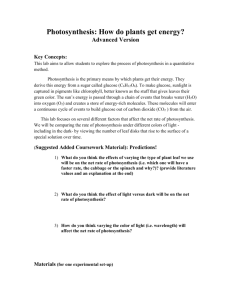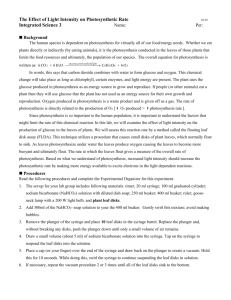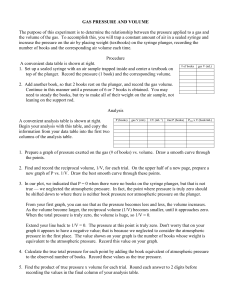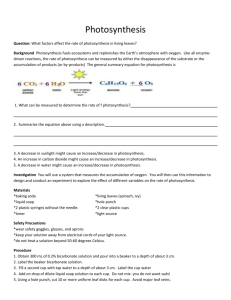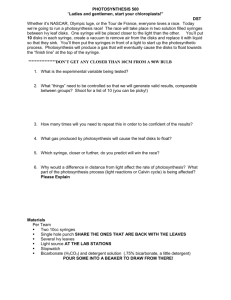Rates of Photosynthesis
advertisement
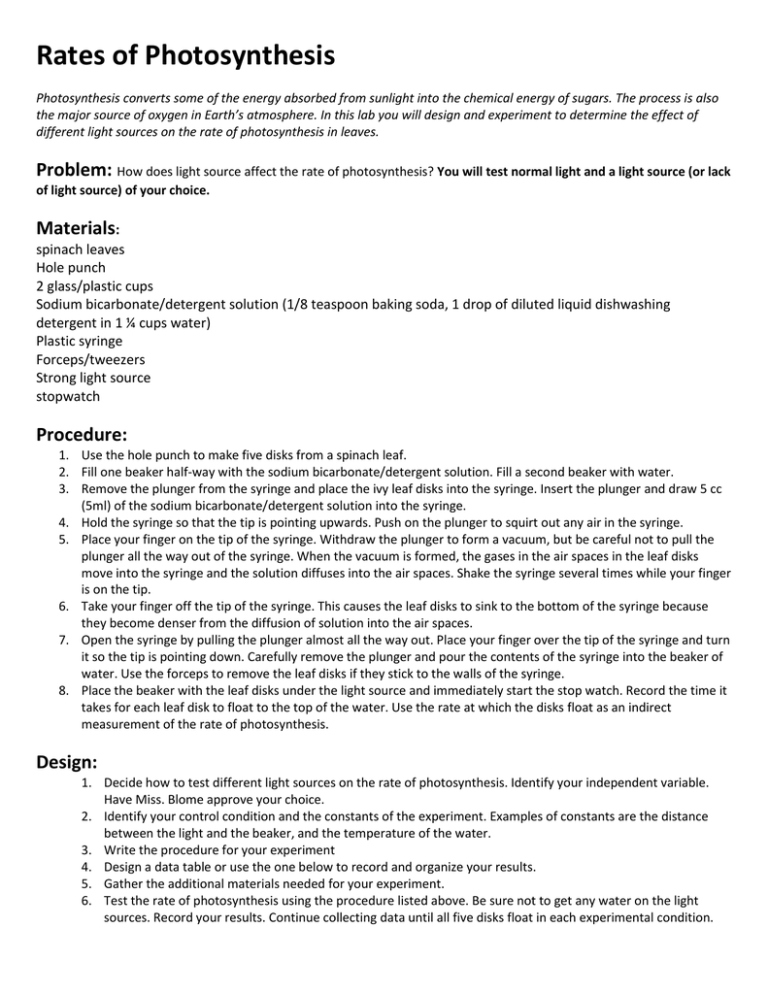
Rates of Photosynthesis Photosynthesis converts some of the energy absorbed from sunlight into the chemical energy of sugars. The process is also the major source of oxygen in Earth’s atmosphere. In this lab you will design and experiment to determine the effect of different light sources on the rate of photosynthesis in leaves. Problem: How does light source affect the rate of photosynthesis? You will test normal light and a light source (or lack of light source) of your choice. Materials: spinach leaves Hole punch 2 glass/plastic cups Sodium bicarbonate/detergent solution (1/8 teaspoon baking soda, 1 drop of diluted liquid dishwashing detergent in 1 ¼ cups water) Plastic syringe Forceps/tweezers Strong light source stopwatch Procedure: 1. Use the hole punch to make five disks from a spinach leaf. 2. Fill one beaker half-way with the sodium bicarbonate/detergent solution. Fill a second beaker with water. 3. Remove the plunger from the syringe and place the ivy leaf disks into the syringe. Insert the plunger and draw 5 cc (5ml) of the sodium bicarbonate/detergent solution into the syringe. 4. Hold the syringe so that the tip is pointing upwards. Push on the plunger to squirt out any air in the syringe. 5. Place your finger on the tip of the syringe. Withdraw the plunger to form a vacuum, but be careful not to pull the plunger all the way out of the syringe. When the vacuum is formed, the gases in the air spaces in the leaf disks move into the syringe and the solution diffuses into the air spaces. Shake the syringe several times while your finger is on the tip. 6. Take your finger off the tip of the syringe. This causes the leaf disks to sink to the bottom of the syringe because they become denser from the diffusion of solution into the air spaces. 7. Open the syringe by pulling the plunger almost all the way out. Place your finger over the tip of the syringe and turn it so the tip is pointing down. Carefully remove the plunger and pour the contents of the syringe into the beaker of water. Use the forceps to remove the leaf disks if they stick to the walls of the syringe. 8. Place the beaker with the leaf disks under the light source and immediately start the stop watch. Record the time it takes for each leaf disk to float to the top of the water. Use the rate at which the disks float as an indirect measurement of the rate of photosynthesis. Design: 1. Decide how to test different light sources on the rate of photosynthesis. Identify your independent variable. Have Miss. Blome approve your choice. 2. Identify your control condition and the constants of the experiment. Examples of constants are the distance between the light and the beaker, and the temperature of the water. 3. Write the procedure for your experiment 4. Design a data table or use the one below to record and organize your results. 5. Gather the additional materials needed for your experiment. 6. Test the rate of photosynthesis using the procedure listed above. Be sure not to get any water on the light sources. Record your results. Continue collecting data until all five disks float in each experimental condition. Your lab write up will include a Title, Hypothesis, Variable table, Procedures (option 1), Data table, Graph and Conclusion (all 4 parts). Time (sec) 0 Type of light ______ (# of disks floating) Type of light ______ (# of disks floating)
